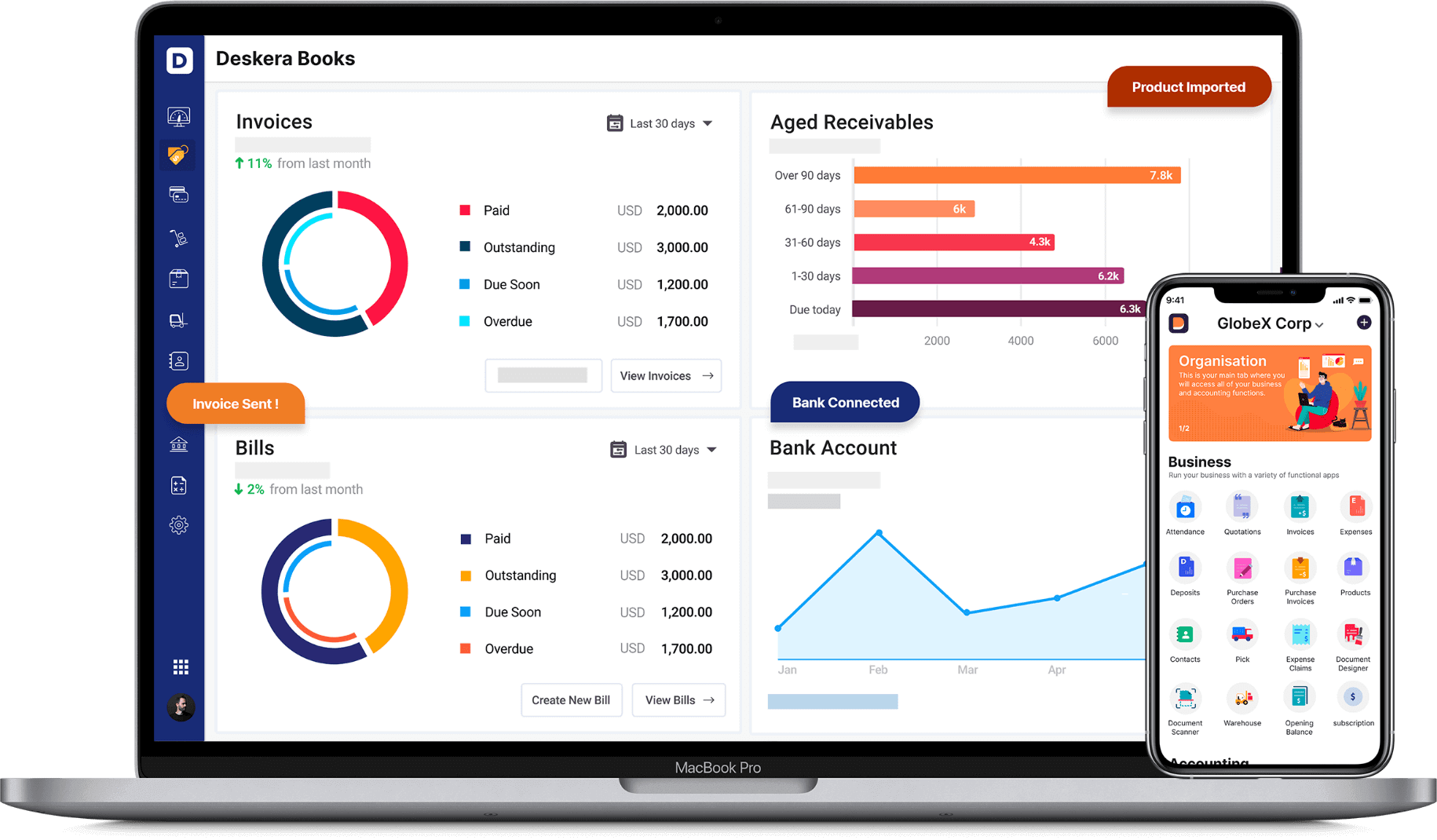Tax on payroll is defined as taxes paid by employers, employees, or the self-employed, either as a proportion of payroll or as a fixed amount per person, and that does not confer entitlement to social benefits. Today, in this article, we will look at the Nebraska payroll taxes.

This article covers the following:
- Nebraska payroll taxes
- How does Nebraska payroll taxes work?
- Federal payroll taxes
- Step-to-step guide to calculating payroll taxes
- Calculating employer payroll taxes
- Nebraska payroll tax resources
- FAQs Nebraska payroll taxes
- How can Deskera assist you?
Nebraska Payroll Taxes
If your small business has employees working in Nebraska, you'll need to withhold and pay Nebraska income tax on their salaries. This is in addition to having to withhold federal income tax for those same employees.
How Does Nebraska Payroll Taxes Work?
Certain deductions, like federal income and FICA taxes, are taken from an employee's paycheck no matter which state they call home. Nebraska, like most states, also deducts money to pay state income taxes.
The first deduction that all taxpayers face is FICA taxes. Employers will withhold 1.45% in Medicare tax and 6.2% in Social Security tax. Any wages that an employee makes over $200,000 are subject to an additional 0.9% Medicare surtax.
The employer matches the employee's Medicare and Social Security tax payments (minus the Medicare surtax), so the total contributions are double what an employee pay.
Keep in mind that if you are self-employed, you are responsible for paying the full amount yourself. Luckily there is a deduction available during tax season that you can use to decrease the bite of this self-employment tax.
Employers will also withhold federal income taxes from the employee’s paycheck. The IRS collects this and counts it toward annual income taxes. How much the employees pay in federal taxes depends on whether the employees are single or married, how much they earn, and whether they elect to have additional tax withheld from their paycheck. All this information is reported on the employee’s W-4 form.
The IRS made significant changes to W-4 in recent years, though. The revised form excludes the use of allowances and removes the option of claiming personal or dependency exemptions.
It also asks filers to enter annual dollar amounts for income tax credits, non-wage income, itemized deductions, and total taxable yearly wages. The form features a five-step process that allows filers to enter personal information, claim dependents, and indicate additional income.
Nebraska’s state income tax system is quite similar to the federal system. It’s a progressive system, which means taxpayers who earn more pay higher taxes. There are four tax brackets in Nevada, and they vary based on income level and filing status.
The lowest tax rate is 2.46%, and the highest is 6.84%. There are no local income taxes in Nebraska. A financial advisor in Nebraska can help you understand how taxes fit into your overall financial goals.
Financial advisors can also help with investing and financial plans, including retirement, homeownership, insurance, and more, to make sure you are preparing for the future.
Federal Payroll Taxes
First and foremost, we have to take care of federal taxes. Here’s a quick overview of the components that go into federal payroll tax withholdings.
Gross wages are simply the amount of money an employee has earned during the last pay period.
For hourly employees, multiply the number of hours worked by their pay rate and make sure you don’t forget to consider overtime.
For salaried employees, divide each employee’s annual salary by the number of pay periods you have over a year. Bonuses, commissions, and tips are all part of gross wages.
Subtract any pre-tax withholdings if your employees have 401(k) accounts, flexible spending accounts (FSA), health savings accounts (HSA), or any other pre-tax withholdings, subtract them from gross wages before applying payroll taxes.
Deduct federal income taxes can range from 0% to 37%. We won’t get into the nitty-gritty here, but you can find further withholding information through the IRS Publication 15-T.
Deduct and match any FICA taxes to cover Social Security and Medicare taxes:
For Social Security tax, withhold 6.2% of each employee’s taxable wages until they have earned $147,000 in a given calendar year. As an employer, you must match this tax.
For Medicare tax, withhold 1.45% of each employee’s taxable wages until they have earned $200,000 in a given calendar year. You must also match this tax. For employees who earn more than $200,000 per year, you’ll need to withhold an Additional Medicare Tax of 0.9%, which brings the total employee Medicare withholding above $200,000 to 2.35%. You don’t need to match the Additional Medicare Tax. Only employees are responsible for paying this tax.
Pay FUTA unemployment taxes, 6% of the first $7,000 of each employee’s taxable income. FUTA taxes come with a huge caveat that you should know about. You can claim a tax credit of up to 5.4% for the state unemployment tax you pay, as long as you pay in full and on time.
It’s an easy way to save a whopping 90%, so make sure you take advantage! Only you, as the employer, are responsible for paying FUTA taxes, so you don’t need to withhold FUTA from your employees’ paychecks.
Subtract any post-tax deductions most of your employees won’t have any post-tax deductions, but if they do, you will need to withhold things like court-ordered wage garnishments, child support, etc. Make sure you consider these as well.
Here is how you can calculate your payroll taxes if you have a business in Nebraska.
Step-to-Step Guide to Calculate Payroll Taxes
If you’re a small business owner trying to figure out how to calculate payroll, you’re not alone. Over six million small businesses in the U.S. are in the same boat as you.
Although the tax code may seem complicated, once you figure out what tax filings are required and learn how to do the math, the process is fairly straightforward.
With that being said, calculating payroll taxes correctly is critical to your employees and your accountant.
We will answer all of your payroll questions here.
Here is a list of new employee documents that are expected of your employees:
- Form W-4: Employee’s Withholding Certificate
- State W-4 (as applicable)
- Direct Deposit Authorization Form
- Form I-9: Employment Eligibility Verification
Form W-4: Employee’s Withholding Certificate
Each new employee must complete the IRS Form W-4, which tells you key information about how much federal income tax (FIT) you’ll need to withhold from their wages. The employee will enter their name, address, and social security number.
The W-4 was revised in 2020. The new form has a five-step process and a new Publication 15-T (Federal Income Tax Withholding Methods) for determining employee withholding. It no longer uses withholding allowances.
For employees hired in 2019 or prior, you can continue to use the information they provided on the old form W-4. It includes a worksheet that allows your employees to calculate withholding allowances for dependents and children.
Some employees may want to fill out a new W-4 if they work a second job, get married, have a child, or get divorced, but you cannot require existing employees to complete a new one.
Employees can also elect to have additional tax withheld or request exemption from federal income tax withholding. The new form W-4 provides detailed instructions.
Ensure the employee signs the W-4, but don’t send it to the IRS unless requested. Retain it in your employee’s personnel file for a minimum of 4 years after the employee’s latest tax return.
State W-4
Some states have their withholding forms. Form W-4 will often be used to calculate state and/or local income tax withholding for states that don't. A complete list of applicable state tax forms can be found on the Federation of Tax Administrators website.
Direct Deposit Authorization Form
As an employer, you can pay your employees in several different ways: paper checks, direct deposits, prepaid debit cards, or cash. Direct deposit is often the easiest and most secure way to deliver paychecks, so it is the most popular.
More than 82% of US workers are now being paid by direct deposit. An employee who chooses to be paid by direct deposit must fill out a direct deposit authorization form, complete with bank routing numbers and account numbers.
The form acts as a permission slip for you to deposit the employee’s net pay electronically into their bank account. As part of the verification process, many employers will ask for a voided blank check to confirm the accuracy of the bank account information provided by the employee.
Form I-9: Employment Eligibility Verification
New employees fill out a Form I-9 to certify that they are legally permitted to work in the United States (i.e., as a citizen, permanent resident, work visa holder, etc.). They can prove their work status by either providing you their US passport or their driver’s license and Social Security card.
You are required by law to obtain a signed Form I-9 from your employee by law before employment commences. You should retain the completed form and any supporting documents in your employee’s personnel file.
You might also want to have new employees acknowledge their receipt of the company handbook, code of conduct, and any other formal policies at this time.
While the acknowledgment isn’t necessary for payroll calculations, it’s best to have your new employees complete all required company forms simultaneously. HR software can make it easy to manage all these tasks.
Calculating Employee Payroll Taxes in 5 Steps
Here is how you can calculate employee payroll taxes:
Step 1: Figure Out Gross Pay
Gross pay is the original amount an employee earns before any taxes are withheld.
Gross pay is the number of hours worked during the pay period multiplied by the hourly rate for hourly employees. For example, if your receptionist worked 40 hours a week at $20 an hour, his gross pay for the week would be 40 x $20, or $800.
Don’t forget to include any overtime pay, typically 1.5 times the normal pay rate when an hourly employee works more than 8 hours a day or 40 hours a week. In this example, your receptionist would earn $20 for each of the first 40 hours worked, plus $30 for the 41st and any additional hours during the week.
For salaried employees, who are exempt from the overtime rules, gross pay will generally remain unchanged each pay period. Simply divide their salary by the number of pay periods in a year. For example, if a manager earns an annual salary of $50,000 and receives a paycheck twice a month, gross pay, each pay period is $2,083.33 ($50,000/12 months/2 monthly pay periods).
In addition to wages, gross pay includes any commissions, tips, and bonuses the employee earns.
Step 2: Calculate Employee Tax Withholdings
Once you know an employee’s gross pay and the number of allowances from their W-4, you can figure out how much you need to withhold to cover their taxes. In most states, you’ll need to withhold federal and state taxes and FICA taxes from each paycheck.
FICA TAXES
The Federal Insurance Contributions Act (FICA) taxes are Social Security and Medicare, which must be withheld from all employees unless otherwise exempt.
- Social Security is a flat 6.2% withholding tax for wages up to $142,800 for the 2021 tax year. Any annual salaries above $142,800 are exempt, which means that the cumulative yearly Social Security withholding cannot exceed $8,853.60 ($142,800 x 6.2%). For our example employees, we would take their gross wage of $2,083.33, multiply it by 6.2%, and withhold $129.17 from their paycheck.
- Medicare is also a flat tax, at a rate of 1.45%. There is no annual limit for Medicare taxes, but employees who earn more than $200,000 a year are subject to the Additional Medicare Tax of 0.9%. We multiply our employee’s gross wage of $2,083.33 by 1.45% and arrive at $30.21 for Medicare tax.
Our employee’s FICA tax per pay period is thus $129.17 + $30.21 = $159.38.
State and Local Taxes
Some states (like Florida) have no state income taxes, so you may be off the hook. But if you’re required to pay state taxes, you’ll want to make sure your calculations are done right.
Different states apply payroll taxes differently, but once you know how to calculate the FIT and FICA taxes, calculating state taxes is a similar exercise. Also, check whether your state imposes local taxes that are paid on top of federal and state taxes.
Step 3: Take Care of Deductions
In addition to withholding for payroll taxes, calculating your employees’ paycheck also means taking out any applicable deductions.
There is voluntary pre, and post-tax deductions like health insurance premiums, 401(k) plans, or health savings account contributions. Some employees also have involuntary deductions that may need to be considered for items like child support or wage garnishments (you’ll know if you need to withhold these things because you’ll receive an order from a judge, the IRS, or the state).
Be careful here because pre-tax deductions like 401(k) are taken out of gross income in Step 1, which means the tax withholding calculation in Step 2 will be lower. Post-tax deductions are taken out after Step 2. Pre-tax deductions will save the employee more taxes.
Step 4: Add on Any Expense Reimbursements
If your employee paid for any company expenses out of their pocket, they expect to be reimbursed. Employers can either pay reimbursements separately from payroll or combine them with payroll.
Remember that expense reimbursement is not part of gross wages and thus not subject to tax withholding. At the end of your calculation, any expenses you reimburse to employees should be made in full and added to net pay.
Step 5: Total It All Up
Once you’ve done all the math to figure out gross pay, tax withholdings, deductions, and reimbursements, you’ll have what you need to calculate the paycheck:
- Start with gross pay
- Subtract employee tax withholdings
- Subtract deductions
- Add on any expense reimbursements
- And you get net pay!
Now you know exactly how much money you will send your employee on payday!
Calculating Employer Payroll Taxes
In addition to the taxes you withhold from an employee’s pay, you as the employer are responsible for paying certain payroll taxes as well:
FICA Matching: You must match the employee’s FICA tax withholding, which means your company will pay 6.2% tax for Social Security and 1.45% tax for Medicare. Using our example employee, you as the employer would pay a matching $129.17 for Social Security and $30.21 in Medicare, resulting in a $159.38 FICA obligation.
Unemployment Taxes: You will also have to pay federal and state unemployment taxes. Unemployment taxes are paid only by the employer, not the employee.
Federal Unemployment Tax (FUTA) is 6.0% of the first $7,000 in wages you pay each employee each year. If your company is subject to state unemployment, you can receive a federal tax rate credit of up to 5.4%, making the effective tax rate 0.6%. Once an employee earns more than $7,000 in a calendar year, you stop paying FUTA for that employee in that tax year. Federal Unemployment: $2,083.33 x 0.6% = $12.50
State Unemployment Tax (SUTA) varies by state. Consult with your state’s Department of Labor or Unemployment Revenue for tax rates, wage bases, and filing requirements. We will assume the employee has not yet been paid $7,000 year-to-date for this example. We will use Florida’s unemployment tax rate of 2.7%. State Unemployment: $2,083.33 x 2.7% = $56.25
Thus, your obligation as the employer during this pay period is $129.17 + $30.21 + $12.50 + $56.25, which comes out to a total of $228.13.
You’ve calculated payroll and paid your employees doesn’t mean your job is done. You also need to send the taxes you withheld (i.e., FIT, FICA, state, and local income taxes) to the respective taxing authority. For FIT and FICA, that is the IRS. For state and local income taxes, that is your state’s withholding tax agency.
Be sure to send both the taxes you withheld from your employee’s paycheck and the taxes that you as the employer are responsible for.
The timing of when you send the federal taxes depends on how much you pay employees, how frequently you pay them, and your lookback period. The IRS Form 941, Employer’s Quarterly Federal Tax Return, provides details on how, when, and where to pay FIT and FICA.
The deadline to file Form 941 is the last day of the month, following the end of a calendar quarter. For example, for the quarter ending on March 31st, Form 941 is due on April 30th. There are significant penalties for not filing this form, so don’t forget!
For state tax filings, you should contact your state’s withholding tax agency for filing requirements for state and local income tax rates. Each state is different.
Employer Unemployment Taxes
All businesses in Nebraska must pay State Unemployment Tax Act (SUTA) taxes. The current rate for negative-rated employers and for all new construction employers is 5.4% of the first $9,000 of each employee’s taxable income.
For existing businesses not in the construction industry, their rate is 1.25%. Businesses that pay SUTA in full and timely can claim a tax credit of up to 5.4% on your Federal Unemployment Tax Act (FUTA) taxes.
Workers’ Compensation
Nebraska businesses with one or more employees must carry workers’ compensation insurance. Workers’ comp premiums will vary depending on the industry in which your company operates. Exceptions to this requirement include:
- Railroad employees
- Volunteers
- Independent contractors
- Domestic workers
- Some agricultural businesses
- Sole proprietors
Income Taxes
For employees, income taxes are a big item you need to keep in mind as more employers allow remote work. If an employee lives in Nebraska but works in another state, they may have to pay Nebraska state income tax, as Nebraska does not currently have reciprocity with any other states.
This could cause some employees to pay more in taxes. For most employees, you will need to deduct state income taxes from each paycheck.
Nebraska Minimum Wage
Nebraska raised the minimum wage to $9 per hour in 2016—more than the $7.25 federal minimum wage. For tipped employees, companies must pay at least $2.13 per hour. If an employee’s tips plus the cash wage do not equal $9 per hour, the business must make up the difference.
Calculating Overtime
If you have employees who are eligible for overtime pay, you must calculate their overtime as 1.5 times their regular rate. An employee is eligible for overtime if they have worked over 40 hours in a workweek.
Pay Stub Laws
Nebraska law requires employers to provide employees with a pay stub on each regular payday. Employers may provide the pay stubs to the employee by mail, email, paper copy, or through payroll software like Deskera. The pay stub must clearly state:
- Company name
- Hours the employee worked
- Wages earned
- Deductions made
Federal Payroll Forms
Here is a complete list and location of all the federal payroll forms you should need.
- W-4 Form: Provides information on employee withholdings so you can properly calculate and withhold federal and state income taxes
- W-2 Form: Used to report total annual wages for each employee
- W-3 Form: Used to report total annual wages for all employees
- Form 940: To calculate and report unemployment taxes due to the IRS
- Form 941: Used to file quarterly income tax
- Form 944: Used to file annual income tax
- 1099 Forms: Provides information for non-employee contract work
Nebraska Payroll Tax Resources
- Nebraska Department of Revenue provides many forms, information on the latest laws and regulations, and other employee-specific information.
- Tax withholdings often trip up employees processing payroll; reviewing comprehensive information on Nebraska’s income tax withholding requirements may help you.
- For extensive information on how to get workers’ compensation coverage, Nebraska’s Department of Labor offers guidance.
FAQs Nebraska Payroll Taxes
If I have employees, how do I file state income tax withholding?
First, you need to apply for a Nebraska withholding number Nebraska Tax Application, Form 20, prior to withholding state income taxes from your employees. You will be mailed a Nebraska Withholding Certificate with your state identification number on it.
If you have a payroll service do your payroll, you are still responsible for filing this application before they can start any payroll activity. You should provide them with a copy of the Nebraska Withholding Certificate showing your state identification number and business name.
This will allow them to prepare the returns they file for you with the correct Nebraska identification number. They are not authorized to file any returns for a Nebraska employer until they have received a Nebraska withholding identification number.
What are the state income tax withholding rates?
The rates, brackets, withholding allowance value, special withholding procedures, and withholding tables on wages are located in the Nebraska Circular EN.
What state form is equivalent to the Federal Form W‑4?
The Employee’s Nebraska Withholding Allowance Certificate, Form W-4N, is the state equivalent to the Federal Form W-4. The employee completes the Nebraska Form W-4N to determine the number of allowances that the employer uses in conjunction with the Nebraska Circular EN to calculate the Nebraska income tax withholding. The value of the Nebraska allowance is listed in the Nebraska Circular EN.
When is the Nebraska Form W-4N required?
Beginning January 1, 2020, the Nebraska Form W-4N is used to determine the correct Nebraska income tax withholding when the federal Form W-4 is completed on or after January 1, 2020.
Employees who have completed the federal Form W-4 prior to January 1, 2020, are not required to submit a Nebraska Form W-4N. Employers will continue to use the federal Form W-4 on file for Nebraska withholding purposes.
For every 2020 federal Form W-4 employers receive, a Nebraska W-4N must be completed. Suppose an employee did not complete a federal Form W-4 prior to January 1, 2020, or beginning January 1, 2020, completes a federal Form W-4 but does not submit a Nebraska Form W-4N.
In that case, employers must withhold at a single rate with no withholding allowances. The employer must use the single tables when the Nebraska Form W-4N has not been completed as required.
The rates of 2.26% to 6.95% are dependent on the number of wages, and the single individual's tables should be used with no allowances regardless of marital status.
What do I do if one of my employees wants additional state income tax withheld?
When an employee wants additional state income tax to be withheld, they complete line 2 on the Nebraska Form W-4N. Completing line 2 authorizes the employer to withhold an additional amount from each paycheck. The amount entered is the amount calculated based on the allowances.
How does an employer submit a Form 1099‑MISC and other 1099 forms to the state?
Nebraska does not require payors to submit Form 1099‑MISC or other 1099 forms to DOR unless Nebraska state income tax withheld is to be reported. When Nebraska tax is withheld, the 1099 forms are submitted to DOR with the Nebraska Reconciliation of Income Tax Withheld, Form W‑3N. Several filing options are available, including e-filing using the NebFile for Business program on DOR’s website and combined federal/state reporting.
If I am an employer located in another state, but have employees in Nebraska from time to time, are their wages subject to Nebraska income tax withholding when they are working in Nebraska?
Yes. The wages paid to employees for work done in Nebraska is subject to Nebraska income tax withholding. The only exceptions to this rule are wages paid to railroad crews, airline flight crews, and interstate truck drivers if the employee is a resident of a state other than Nebraska.
How Can Deskera Assist You?
When it comes to filing taxes for your company, you need a system that can help you with it without having to go through a hassle. With Deskera, you have an automated system to file your taxes. Apart from that, managing payroll is another responsibility on your shoulder that takes a lot of work, but with the Deskera payroll system, you can do it hassle-free.

Key Takeaways
- If your small business has employees working in Nebraska, you'll need to withhold and pay Nebraska income tax on their salaries.
- Certain deductions, like federal income and FICA taxes, are taken from an employee's paycheck no matter which state they call home.
- Gross wages are simply the amount of money an employee has earned during the last pay period.
- Each new employee must complete the IRS Form W-4.
- Form W-4 will often be used to calculate state and/or local income tax withholding for states that don't.
- The Federal Insurance Contributions Act (FICA) taxes are Social Security and Medicare, which must be withheld from all employees unless otherwise exempt.
- Different states apply payroll taxes differently, but once you know how to calculate the FIT and FICA taxes, calculating state taxes is a similar exercise.
- In addition to withholding for payroll taxes, calculating your employees’ paycheck also means taking out any applicable deductions.
- All businesses in Nebraska must pay State Unemployment Tax Act (SUTA) taxes.
- Nebraska businesses with one or more employees must carry workers’ compensation insurance.
Related Articles:














